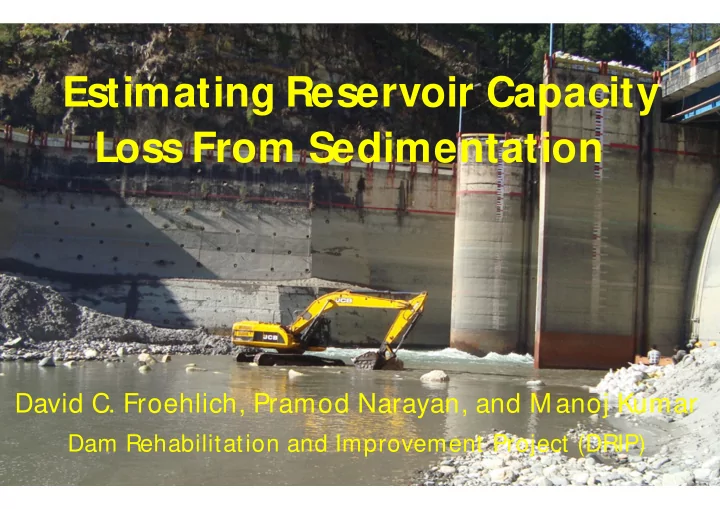

Estimating Reservoir Capacity Loss From Sedimentation David C. Froehlich, Pramod Narayan, and M anoj Kumar Dam Rehabilitation and Improvement Project (DRIP)
Estimating Sedimentation – Three Approaches • From sediment discharge rating curves combined with flow-duration relations. • From calculations of the total amount of land surface erosion, the ability of the sediment to be transported to the reservoir, and the reservoir trapping efficiency. • From predictions based on sedimentation in existing reservoirs in which the accumulated deposits have been surveyed over a sufficiently long period.
General Form of Capacity Loss M odel ˆ ln ln ln ln ln Y A A C T 1 2 3 4 5 c r o where ˆ 3 Y expected reservoir capacity loss (Mm ) 2 A reservoir catchment area (km ) c 2 A reservoir surface area (km ) r 3 C initial reservoir storage capacity (Mm ) o T time s ince initial filling of reservoir (years) model parameters i
0.10 0.05 0.8 0.9 0.0064 A A C T ; eastward flowing rivers c r o ˆ Y 0.15 0.30 0.50 0.65 0.030 ; westward flowing rivers A A C T c r o 2 2 0.930 0.881 r r ln Y ln Y east west s 0.601 s 0.492 ln Y ln Y east west
Reservoir Half-life T 50% (years) 1 0.5 5 1 T A A C 4 2 3 50% c r o exp 1 1.11 0.15 0.1 0.3 78.0 A A C ; eastward flowing rivers c r o T (years) 50% 1.54 0.15 0.3 0.5 16.6 ; westward flowing rivers A A C c r o
100 x (1- α )% Prediction Interval 1 ˆ 2 ln 1 f F F f Y t s 2 , ln 0 0 n p Y ln Y two-tailed Student's t-distributio n t 130 (eastward), 90 (westward) n 5 , , , , p 1 2 3 4 5 f 1,ln ,ln , n l ,ln A A C T 0 c r o 0.53544 0.01893 0.02723 0.01289 0.11471 0.71542 0.04684 0.05769 0.02803 0.13602 0.01893 0.00406 0.00194 0.00135 0.00102 0.04684 0.01149 0.01089 0.00054 0.00148 1 1 F F 0.02723 0.00194 0.01194 0.00777 0.00253 F F 0.05769 0.01089 0.05549 0.03532 0.00830 ln Y ln Y east west 0.01289 0.00135 0.00777 0.00832 0.00080 0.02803 0.00054 0.03532 0.03160 0.00854 0.11471 0.00102 0.00253 0.00080 0.030 75 0.13602 0.00148 0.00830 0.00854 0.043 25 Eastward flowing rivers Westward flowing rivers
Upper 95% prediction limit Lower 95% prediction limit
Upper 95% prediction limit Lower 95% prediction limit
Summary and Conclusions 0.10 0.05 0.8 0.9 0.0064 A A C T ; eastward c r o ˆ Y 0.15 0.30 0.50 0.65 0.030 A A C T ; westward c r o 1.11 0.15 0.1 0.3 78.0 ; eastward A A C c r o T 50% 1.54 0.15 0.3 0.5 16.6 A A C ; westward c r o 1 ˆ 2 ln Y t s 1 f F F f 2 , n p ln Y 0 0 ln Y
Recommend
More recommend